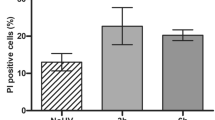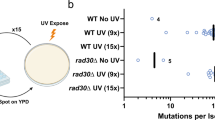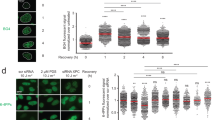Abstract
The purpose of this study is to better understand the roles of the p53 tumor suppressor protein and the product of the p53-regulated gene p21WAF1 in the response of diploid human dermal fibroblast cultures to 254 nm ultraviolet (UV) light. We report that Li–Fraumeni syndrome (LFS) fibroblast strains heterozygous for TP53 mutation at either codon 245 or 234 exhibit markedly reduced or no expression of p21WAF1 following UV irradiation, respectively. These strains also exhibit defective nucleotide excision repair and pronounced inhibition of RNA synthesis following UV exposure, both of which are molecular hallmarks of cells derived from patients with the UV-sensitive syndrome xeroderma pigmentosum. In sharp contrast to xeroderma pigmentosum cells, however, the repair-deficient LFS cells show abnormal resistance, rather than hypersensitivity, to the killing effect of UV light. We further demonstrate that exposure of normal human fibroblasts to biologically relevant fluences (⩽15 J/m2) of UV does not induce apoptotic cell death, indicating that UV resistant phenotype displayed by LFS strains is not associated with deregulated apoptosis. In normal fibroblasts, such treatment results in a moderate (∼threefold) up-regulation of p53 protein, induction of the p21WAF1 gene, and a senescence-like growth arrest. On the other hand, exposure to ⩾20 J/m2 UV results in a striking up-regulation of p53, inhibition of p21WAF1 expression, and activation of an apoptotic pathway. We conclude that: (i) p21WAF1-mediated senescence is the principal mode of cell death induced by ⩽15 J/m2 UV light in normal human fibroblasts; (ii) there is a threshold effect for p53-dependent apoptosis and that, in normal human cells, this threshold level is induced upon expsoure to ∼20 J/m2 UV; (iii) the p53 signaling pathway is malfunctional in the TP53 heterozygous LFS strains examined; and (iv) the enhanced resistance to UV-induced cell killing displayed by these LFS strains is a consequence of diminished growth arrest, which is presumably mediated by p21WAF1 and not abnormalities in an apoptotic pathway.
This is a preview of subscription content, access via your institution
Access options
Subscribe to this journal
Receive 50 print issues and online access
$259.00 per year
only $5.18 per issue
Buy this article
- Purchase on Springer Link
- Instant access to full article PDF
Prices may be subject to local taxes which are calculated during checkout
Similar content being viewed by others
Author information
Authors and Affiliations
Rights and permissions
About this article
Cite this article
Barley, R., Enns, L., Paterson, M. et al. Aberrant p21WAF1-dependent growth arrest as the possible mechanism of abnormal resistance to ultraviolet light cytotoxicity in Li–Fraumeni syndrome fibroblast strains heterozygous for TP53 mutations. Oncogene 17, 533–543 (1998). https://doi.org/10.1038/sj.onc.1202271
Received:
Revised:
Accepted:
Published:
Issue Date:
DOI: https://doi.org/10.1038/sj.onc.1202271
Keywords
This article is cited by
-
Metabolic labeling of human cells with tritiated nucleosides results in activation of the ATM-dependent p53 signaling pathway and acceleration of DNA repair
Oncogene (2003)
-
UV-radiation induces dose-dependent regulation of p53 response and modulates p53-HDM2 interaction in human fibroblasts
Oncogene (2001)
-
P53 plays a protective role against UV- and cisplatin-induced apoptosis in transcription-coupled repair proficient fibroblasts
Oncogene (2001)
-
Role for p53 in the Recovery of Transcription and Protection Against Apoptosis Induced by Ultraviolet Light
Neoplasia (1999)



